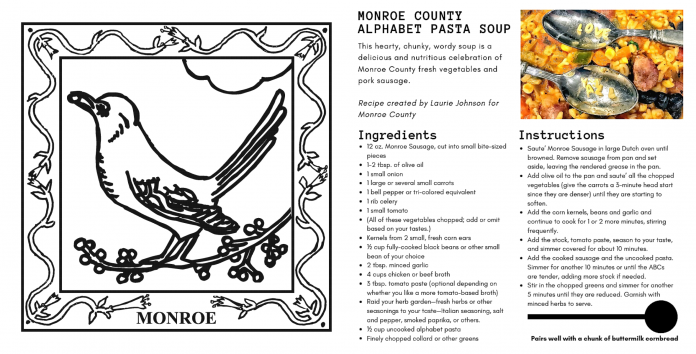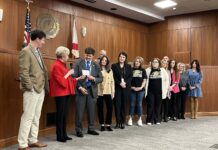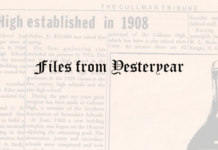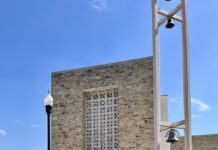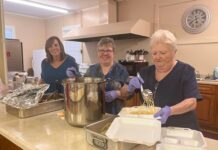The Alabama honeysuckle border was inspired by an 18th century, Southern applique quilt.
The Cullman Tribune is celebrating the Alabama Bicentennial (1819-2019) with statewide field reporting by Alabama Master Gardener/Botanical Artist Ben Johnson South. This year-long feature, "The 67-County Alabama Garden Party," will spotlight different counties each week. Each county will get its own "quilt block," along with a historical profile, and we'll share a recipe specific to the area. At the end of the year, all 67 counties will be put in a book to commemorate the Bicentennial.
Monroe County
Maybe there’s something in the very soil of Monroe County, Alabama that causes the best writers to blossom. It could be what the French wine appellations call “terroir” (from “terre,” land), those unique factors in the place that give it a distinctive flavor.
Monroe County has produced more world-class storytellers than the Renaissance produced saints or the University of Alabama and Auburn University together have produced national football champions. This internationally acknowledged and state legislature-christened “Literary Capital of Alabama” nurtured the tender talents of Truman Capote, Cynthia Tucker, Mark Childress, Nelle Harper Lee and a wagonload of others. (Insider note: Cynthia Tucker is one of America’s most gifted and recognized editorial writers, but in her hometown of Monroeville, she is still bragged on as Mary Tucker’s smart, writing daughter. Mary is a beloved English professor and progressive leader of literature and arts in Alabama.)
This is Alabama timber and farm country as well as writer and word country. I visited the county many times during the almost 20 years my brother was president of the community college in Monroeville. As I exited the interstate and drove through lush, green pastureland and deep forested woodlands, the image my brain conjured was of those cartoons where a fellow is dragging himself across the land with his hand outstretched for water, except, my caption read, “A word, please, I need a word.”
Monroe County was established in 1815, four years before Alabama became a state. The most famous writer from this area during the 19th century was a schoolteacher and soldier, William Barret Travis, who traveled from his Alabama home to what is now Texas to help defend The Alamo. Travis’ important role was as a war correspondent and military recruiter. His impassioned words are a salute to the resilient character of people in this part of the world, most famously in a rousing letter known as “Victory or Death.” This former Monroe County man of letters died in battle at The Alamo.
Since this Bicentennial series of stories is celebrating how PLANTS + PEOPLE come together in Alabama, let me remind you that until the mid-1800s, the paper used by Monroe County writers was likely made from recycled linen and cotton rags. Inks were made from the charred, native woods. People in these parts embraced sustainability and repurposing from the earliest days. (See, “200 WAYS TO SAVE ALABAMA FOR THE NEXT 200 YEARS”) Writing paper since the American Civil War has mostly come from large plants called trees.
Thanks to my brother, who was instrumental in Monroe County celebrating its extraordinary literary heritage, I was able to meet Pulitzer Prize winners like Diane McWhorter and Rick Bragg, and this year’s winner of The Harper Lee Award for Alabama's Distinguished Writer of the Year, Daniel Wallace, author of “Big Fish.” I also met wordstars (think rockstars but generally with less cash and carnality) like Winston Groom, Forrest Gump’s godfather, and George Plimpton, who helped birth, “The Paris Review” and inject-yourself-into-the-plot “participatory journalism.”
The patrician and plummy-voiced but good-natured good ole boy, Mr. Plimpton, was down to enjoy Monroe County hospitality and share recollections from a recent book he edited, “Truman Capote: In Which Various Friends, Enemies, Acquaintances and Detractors Recall His Turbulent Career.” Speaking of this fertile part of Alabama, Mr. Plimpton shared this quote from Monroeville’s Capote, “The true beloveds of this world are in their lover’s eyes lilacs opening, ship lights, school bells, a landscape, remembered conversations, friends, a child’s Sunday, lost voices, one’s favorite suit, autumn and all seasons, memory, yes, it being the earth and water of existence, memory.” Folks, that natural and writerly beauty is in the soil and the soul of Monroe County.
To get the lay of the land since I was last in Monroe County and talk about PLANTS + PEOPLE in the area, I was told the “go-to” town ambassadors are Nathan Carter and Laura Richeson Harris, whom I could find perched in the middle of the historic Monroeville Downtown Square at the Old Courthouse Museum. I reached Laura, who manages the museum’s flocked to, much chirped about, Bird’s Nest Gift Shop. Her enthusiasm for all things Monroe County was contagious. Her son, Thomas, daycare-age but a true Monroe Countian, is already interested in books and storytelling. Laura regularly eats lunch in the, her words, “GLORIOUS GARDEN,” on the Old Courthouse Museum lawn which has representative native plants from throughout the county. Her husband, Justin, works at Scotch Plywood Company in the Beatrice community. I couldn’t have talked with a more plant-centric person had I, well, cultivated the friendship and planted it in this story. YAY MONROE COUNTY PLANTS + PEOPLE! Surely there’s a Monroe County sports team called “The Bookies.” The Timberwolves? The Peckerwoods?
Here are some favorite PLANT + PEOPLE things for you to explore when you visit Monroe County and an original recipe my longtime, Monroeville resident, Martha Stewart-caliber hostess, chemical engineer, sister-in-law, Laurie Johnson, created for Monroe County Alphabet Pasta Soup, which exalts an array of fresh produce from the farmers’ markets in Frisco City and the county seat, and locally-ground Monroe County Sausage. The soup photo Laurie shared is a valentine to everyone in the county, cleverly written in alphabet pasta: just two, spooned up words—LOVE Y’ALL.
*MONROE COUNTY FARMERS’ MARKETS—Savor the luscious, locally-grown produce sold at these farm stands (Frisco City and Monroeville), the Facebook pages with clever writing and beautiful images are enough to lure one to come gather a bushel basket of peppers, tomatoes, squash, potatoes, herbs, corn, fresh flowers, berries, eggplant, plums, cabbage, collards, purple hull peas, okra, zipper cream peas, broccoli, turnips, radishes and just about everything else an Alabama garden can grow as well as homemade preserves, vinegars, honey and Molly Makes baked goods, made from scratch by Molly MacCaughelty.
*U PICK ORCHARD—Hickory Hollow Vineyard (Frisco City) has 11 varieties of muscadines and is open seven days a week in prime plucking season, which is mid-August to late-September.
*SOUTHERN FARM SUPPLY is a local business owned by Ben and Lindsey Busby, a young, forward-thinking couple, who bought out the longtime garden shop and farmers’ supplier, Central Farm Supply and reimagined it for 21st century plant lovers; BUY LOCAL, GROW LOCAL, EAT LOCAL, THRIVE LOCAL.
*FRUITCAKE FESTIVAL—Each fall this fundraiser, underwritten by the Old Courthouse Museum’s dynamic endowment board, celebrates Capote’s sweet memory of Monroeville from his timeless tale, “A Christmas Memory.” For the past several holiday seasons, one of Alabama’s most celebrated storytellers, Dolores Hydock, has delivered an audience-delighting, spell-binding retelling of the work.
*THE ROOFTOP GARDEN OF THE PROP AND GAVEL—Allows a bird’s eye view of the historic Monroeville Downtown Square and is a prime place to sip a Tequila Mockingbird cocktail.
*ALFRESCO DINING AT MEL’S DAIRY DREAM—This cinder block local landmark (where writer Harper Lee’s childhood home stood) serves yummy treats and encourages outdoor dining at its tables through all seasons since there are no inside tables… or you could get takeout and walk two blocks to the FREE picnic tables on the Old Courthouse Museum lawn.
*OUTDOOR PHOTOGRAPHY WITH AARON WHITE—I asked this photographer, who has captured the landscape beauty and everybody’s beautiful, family photos for four decades since hanging up his ballcap as sportswriter for The Monroe Journal, where, if a plant tourist wanted to photograph or paint the botanical bounty of Monroe County, he would send them; Mr. White had many suggestions, but his personal favorite view is on the ferry road leading to Haines Island. Last night at a book signing event at the North Alabama Agriplex, I spent some time with Ken Wills, the lead author of “Exploring Wild Alabama,” which is a guide to all the state’s publicly-accessible natural areas. Wills shares White’s appreciation of the Haines Island area; Wills was rapturous about the ravines filled with beech-magnolias, mapleleaf viburnum, white ash and tulip poplars.
*HIDDEN GARDEN—Nathan Carter suggests “the old Faulk property owned by Truman Capote’s kin, especially Jenny’s fish pond and the japonicus,” most any local can guide you.
*RAILS TO TRAILS—There are 2 miles of hiking and biking trails in the Tunnel Springs area with plans to extend this repurposed land to Beatrice.
*BEST BOOK LOVER SHOPPING—Richeson Harris offers a great selection of works by Alabama writers at the Bird’s Nest Gift Shop in the Old Courthouse Museum. Also, the West Claiborne Marketplace has wonderful antiques, some crafted locally, and lots of books.
*BEAUTIFICATION AWARD-WINNING DOWNTOWN SQUARE—Monroeville is one of the prettiest, “book towns” in the “word world” thanks to the tireless efforts of the local garden club and Main Street Director, Anne Marie Bryan.
*RICKARD’S MILL—A water-powered grist mill built in 1945 where you can still watch corn and other Monroe County grain being transformed for cooking; take home a bag or five.
*PUBLIC LIBRARY IS THE REPURPOSED LA SALLE HOTEL WHERE GREGORY PECK STAYED—We’re told the adoring local and tourist ladies didn’t let the handsome, Hollywood actor get a lot of rest when he visited Monroeville to prepare for his career-making role as Atticus Finch in the 1962 film, “To Kill A Mockingbird” (screenplay written by Horton Foote), but the librarians promise not to pester you in this written and spoken word sanctuary.
*PAUL NEILSEN HANDMADE FURNITURE—This Monroe County wood artisan carefully selects beech, sycamore and cherry trees from local and south Alabama forests for his highly coveted tables and cabinets; young Mr. Neilsen, a local conservationist, also uses non-commercially desirable woods such as those salvaged from fruit and nut trees.
*TO KILL A MOCKINGBIRD—Just opened on Broadway with a new, hit play written by Aaron Sorkin; the New York City stage actors coming to Monroe County to root themselves in their characters terroir, include Will Pullen (Jem), Gideon Glick (Dill) and Celia Keenan-Bolger (Scout), as well as sound designer Scott Lehrer.
*BEST PLACE TO HEAR MONROE COUNTY SONGBIRDS—Stroll around the lawn of the Old Courthouse Museum and then around town; mockingbird trilling and other birdsongs provide you an ideal soundtrack for your visit—they could sell CDs of this beautiful, natural music at the Bird’s Nest, ask Richeson Harris, who is a true innovator and can conjure such wishes into reality.
*PLANTING AN IDEA—Monroe County, “The Literary Capital of Alabama” is an ideal location for an Alabama Wordgarden; I’m imagining an open-air writer’s pavilion with great wi-fi connections; garden benches embellished with quotes from Alabama writers—how about “Mom was a flower of the south” by Mark Childress and “The thorns on every rose bush remind me of my father’s sharp wit” by Jeremy Young; the beautifully worded stanzas of Alabama poet-laureate-in-the-making, Will Justice Drake; and walking stones with Alabama quotes from Hank Williams to the parts of “Gone with the Wind” Margaret Mitchell wrote when she lived in Birmingham. Alabama words and writers could radiate from this rich soil. Asian rice paper plants are a superb addition to an Alabama garden and perfect for the Alabama Wordgarden.
Y’ALL COME to Monroe County on your Alabama Garden Party tour. This is one of the best places on the planet to celebrate the positive and pleasurable ways PLANTS + PEOPLE come together. Mark my word.
MONROE COUNTY ALPHABET PASTA SOUP
This hearty, chunky, wordy soup is a delicious and nutritious celebration of Monroe County fresh vegetables and pork sausage. (Recipe created by Laurie Johnson for Monroe County.)
INGREDIENTS
- 12 oz. Monroe Sausage, cut into small bite-sized pieces
- 1-2 tbsp. of olive oil
- 1 small onion
- 1 large or several small carrots
- 1 bell pepper or tri-colored equivalent
- 1 rib celery
- 1 small tomato
- (All of these vegetables chopped; add or omit based on your tastes.)
- Kernels from 2 small, fresh corn ears
- ½ cup fully-cooked black beans or other small bean of your choice
- 2 tbsp. minced garlic
- 4 cups chicken or beef broth
- 3 tbsp. tomato paste (optional depending on whether you like a more tomato-based broth)
- Raid your herb garden—fresh herbs or other seasonings to your taste—Italian seasoning, salt and pepper, smoked paprika, or others.
- ½ cup uncooked alphabet pasta
- Finely chopped collard or other greens
- Minced parsley or other fresh herbs for garnish
DIRECTIONS
- Saute’ Monroe Sausage in large Dutch oven until browned. Remove sausage from pan and set aside, leaving the rendered grease in the pan.
- Add olive oil to the pan and saute’ all the chopped vegetables (give the carrots a 3-minute head start since they are denser) until they are starting to soften.
- Add the corn kernels, beans and garlic and continue to cook for 1 or 2 more minutes, stirring frequently.
- Add the stock, tomato paste, season to your taste, and simmer covered for about 10 minutes.
- Add the cooked sausage and the uncooked pasta. Simmer for another 10 minutes or until the ABCs are tender, adding more stock if needed.
- Stir in the chopped greens and simmer for another 5 minutes until they are reduced. Garnish with minced herbs to serve.
Pairs well with a chunk of buttermilk cornbread with Rikard’s Mill cornmeal.
Many thanks to Laura Richeson Harris, Aaron White, Nathan Carter, and Ken Wills for all the Monroe County PLANTS + PEOPLE information and thanks to my favorite sister-in-law, Laurie Johnson, for the Hearty, Chunky, Wordy Monroe County Alphabet South recipe.
Also, check out Alabama Bicentennial: 200 ways to save Alabama for the next 200 years.
Copyright 2019 Humble Roots, LLC. All Rights Reserved.

